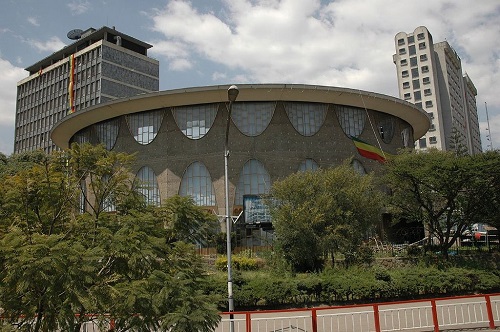CC photo
By
Teklebirhan Gebremichael
The Raison D’etre of Banking
Banks mobilize private and government, domestic and foreign savings and channel them into investment and consumer spending via credit, thus matching production with consumption, and supply with demand. Of course, they do not do it for free. They earn income and make profit by charging interest, service charges, exchange commissions, and fees.
Banks essentially deal in money. Their trade-in-stock is currency. In Ethiopia currency is printed (or is caused to be printed) by the National Bank of Ethiopia, the country’s central Bank. It is then emitted into the economy through credit to the government and to other Banks. Currency itself is what is known as high-powered money because of its high degree of liquidity, i.e. the immediacy with which it can be spent.
Banks collate money other than seed currency through credit when they lend money to their customers. Original cash savings deposited in banks serve as bank reserves against which credit is extended to bank customers who may then deposit the loans back in banks as deposits which are themselves considered as money, albeit a less liquid form of money, but money nonetheless.
Hence, banks create money in the form of demand, savings and time deposits in addition to the physical currency in circulation. This leads to the existence of various classes of money depending on their degree of liquidity. In Ethiopia there are two major classes of money, namely broad and narrow money. Broad money consists of currency in circulation, demand deposits, saving deposits and time deposits. Narrow money, on the other hand, is composed of only currency in circulation and demand deposits, both endowed with high liquidity, currency being the more liquid of the two.
Banking and Economic growth
Because the Banking sector is the source of all classes of money, its potential for creating inflation if it fails to match the supply of money with the supply of physical production in terms of goods and services is quite obvious. In theory, money in the economy should be created to match annual real GDP growth, to replace dilapidated paper and coin currency, and, possibly, to allow for an incentive mild inflation rate of 2-3 percent per annum.
To guarantee such an outcome, it is, therefore, necessary that bank credit, being the source of money, must lead to increases in physical production of goods and services, before it is paid back with interest to the lending bank. Thus it is incumbent on the lending bank to ensure that the credit it extends is used for real productive purposes, at least to make certain (or almost certain) that the loan is repaid with interest on schedule. As is known, it is standard banking practice to ensure repayment of loans through credit risk analysis and monitoring.
Bank credit can become an engine of economic growth if it is so practiced. If not, it could be the main cause of destructive hyperinflation crippling the sinews of the economy. As is well-known, bank credit matched with entrepreneurial talent and other necessary facilities supplements and complements private savings, and works wonders for a nation’s economy.
The situation in Ethiopia
There are now only three government-owned banks, namely, the National Bank of Ethiopia (NBE), the Commercial Bank of Ethiopia (CBE) and Development Bank of Ethiopia (DBE), as the former Construction and Business Bank (CBB) has been merged with the CBE under rather obscure circumstance.
On the other hand, although some vested- interest groups already speak of consolidation, the number of private banks is still under twenty for a population of well over 100 million and a GDP at the current price of nearly trillion Birr.
Bank sector consolidation is a thinly veiled stratagem for entrenching their near-oligopolistic position in the private banking business which happens to be the most lucrative, paying dividends in some cases of well over fifty percent on share capital.
In Ethiopia the rule book for private banks enforced by the monetary and financial authority, which obviously is the NBE, appears to the quite tough, with a minimum debt ratio of 5 percent, a minimum bank establishment capital of 2 billion Birr (recently raised from 500 million Birr), a reserve requirement of at least 5 percent (to be varied as necessary to influence monetary policy), and enforceable benchmarks for net foreign positions.
In fact, draconian regulations have proliferated in recent years, viz, the 27 percent mandatory loan ratio for government bond purchase (actually for the so called grand -renaissance dam on the Blue Nile) and the 30 percent foreign exchange surrender ratio.
However, even under such heavy regulatory circumstance, private banks n Ethiopia have done pretty well, some reporting net profits in excess of well over 500 million Birr, if their financial statements are to believed. Generally, private banks tend to be more careful with loans they grant and concentrate on the main money making operations, including import-export and domestic trade, remittances, other foreign banking services, safe short-term and medium-term loans, etc.
Even then, some private banks, particularly those established along ethnic lines, cannot escape interference by the government, largely, through the spineless NBE, in matters related to credit extension and debt write-offs.
By contrast, the situation with government -owned banks is completely different. The country’s monetarily and financial watchdog, i.e. the NBE, instead of fighting to enforce its own statutory autonomy, has become the servile servant of the EPRDF government, obsequiously agreeing to be answerable to the prime minister, disregarding the option of at least being responsible to parliament. Hence, the NBE put out all the stops to print money and pour it into the coffers of the government with abandon in the form of direct advances, treasury bills and bonds. The NBE irresponsibly removed the time-honored statuary limits on the government borrowing set since the reign of Emperor Haile-Selassie, under the then internationally renowned Governor of the Bank, H.E. Menassie Lemma, who later on deservedly became a member of the global interim committee overseeing reform of the international monetary system, representing sixteen African countries, in the 1970’s.
That was then, this is now the NBE dismantled its key monetary policy committee, replacing it by a talking shop of revolutionary democracy, democratic centralism and draconian EPRDF party discipline. It allowed the CBE to extend unlimited loans to government development agencies without sufficient collateral or guarantee. Such loans are now reported to have up to a staggering total of over 400 billion birr, without any guarantee of repayment. The CBE has also granted billions of birr to EPRDF kleptocrats, apparently without any reliable collateral, mostly for the purpose of constructing high-rise buildings in cities and towns much as the capital Addis Ababa and other towns including Adam, Awassa, etc. It is reported that it is credit like this beyond CBE’s line of business that caused the CCB, the legitimate mortgage bank, to go into apparent bankruptcy, which then forced its merger with the CBE.
The final outcome of all this crazy inflationary financing spree has been, guess what, a 4000 percent cumulative hyperinflation and a 93 percent cumulative depreciation of the national currency (the birr).
Some independent studies have confirmed this appalling inflammatory spiral by finding out that at least 80 percent of the inflation in Ethiopia is caused by excessive monetary expansion, although sycophantic NBE pseudo-economists still maintain, on the basis of, cleverly manipulated monetary and financial statistics that only about 8-10 percent of the inflation is attributable to monetary expansion.
Banking sector reform
It has now become clear to all and sundry that the NBE has failed to control itself and the other government -owned banks, namely, the CBE and the DBE, as admitted by government media too, the DBE has literally been financially eviscerated, with a publicly declared bad debt ratio of 40 percent.
In recent years, it has been reported that the DBE has been defrauded of about five billion birr by EPRDF- related kleptocrats. Recently, the CBE’s usually reportedly hefty annual profit of about 14 billion birr has shown a sudden seasonal drop of about 4 billion birr, raising long-standing doubts about the veracity of its accounting system.
All this points to the necessity of banking sector reform. To begin with, the NBE, the country’s central bank, must regain its statutory autonomy. It should therefore be responsible to parliament rather than to the prime minister. The NBE should re-establish its monetary policy committee and restore its independent and professional stance. Government borrowing limits should be re-instated. The NBE should make use of all available monetary policy instruments, including the rate of interest, reserve requirement, open-market operations, quantitative credit control, moral persuasion, among others, to shape its possibly varying monetary policy stances as circumstance warrant.
Regulatory oversight by the NBE over banks, private and government- owned, should be transparent and impartial. The NBE should strengthen its economic research department to improve on its existing (presumably) macro-econometric model to better follow-up and monitor economic and financial developments. The NBE should immediately consider the possibility and benefit of establishing private currency shops and a stock exchange.
With regard to the CBE and the DBE, the CBE has always had the potential to become a vibrant commercial bank, like its illustrious founding president H.E. Teferra Degufe, meant it to be , if allowed to operate on commercial principles and to stick to its natural line of banking business. On the other hand, unfortunately, we have no such luck with the DBE, which must be completely structured and re-established afresh. Similarly, CBB’s merger with CBE should be scrapped and a robust mortgage bank should be re-established.
When we turn over attention to private banks, for God sake remove their disgusting ethnic scare masks! Allow and facilitate the establishment of more private banks to end their present near-oligopolistic stranglehold on the market. Reduce the current NBE over-regulation on them. Make sure bank shares are widely available to the public in the spirit of people’s capitalism. Once the necessary banking sector reforms are made and are believed to have taken root, the question of participation of foreign banks in the Ethiopia banking sector may be seriously considered.
The first steps may be taken in the form of graduated percentage equity participation. Finally, banking sector reform may well define the future of Ethiopia’s economic development. It goes without saying that capital in the form of sound bank credit must be combined with entrepreneurial talent to create value which in fact is the essence of economic growth and development.



No Comments Yet!
You can be first to comment this post!